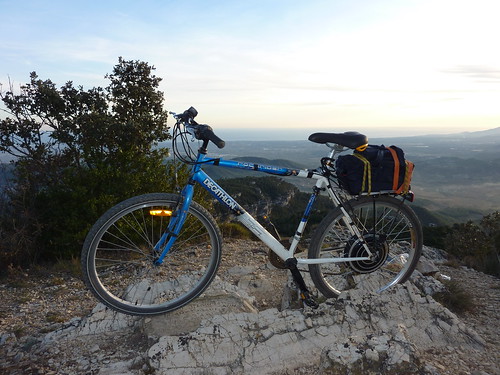From the Volttour meeting (http://www.volttour.net)
And from the Mussara and Albiol trips:




Ideal: 48V, 1kW motor, 15A 4kg or less batteries, boost converter (from 24V to 48V) with current limitter (battery protection).
Other: Mount traction on a back trailer instead of bicycle.




First, we have connected all the wires excepting for number 5 (Cruise Control). The motor should turn in one direction (forward or backwards) and each time the throttle is pushed, the wheel should turn in the opposite direction. In our case, this was not happening. It was always running forward, but with some noise, low torque and the controller and wires were very hot. After connecting and disconnecting everything several times, we saw the expected behaviour. Then, we disconnected the blue wires (just after the motor was going forward), to keep the configuration.
Regeneration starts only when the brake levers are pressed. The braking caused by the motor is quite powerful, but not excessive. Actually, the original brakes of the bike were not powerful enough due to the increase in weight and speed, and the regenerative braking is a great help. In fact, most of the time, we don't even use the brake pads. We just push a brake lever slightly, so that the regeneration kicks in and stops the bike quite quickly.
The Cruise Control function is great. If the throttle is fixed for 8 seconds, then it can be released and the power is maintained until the brakes are used. The only problem is to keep the thumb throttle completely still for 8 seconds. Any vibration or slight movement is detected.
To sum up, the Regenerative Controller is highly recommended: it helps braking, and recharges the battery noticeably (we are now taking some measurements).


After some trials with the Pedelec sensor, I do not recommend it (at least the one I tried).
I found two main drawbacks:
- First of all, it's not a progressive system. I thought that the faster you pedaled the more power the motor would supply. But, it's not like this. If you move the pedals (no matter how slow), you have full power from the beginning (there is a 1 second delay). If you stop pedalling, the motor stops completely (with a 2 second delay). This is not a good thing when it comes to comfort and battery life.
- It takes about 2 seconds for the motor to stop once you have stopped pedaling. This is really dangerous with a 1KW motor. It has some delay (about 1 second) when starting pedaling, too, but this is not really a problem (you get use to it easily).
To sum up, I was really disappointed with the Pedelec system. It needs lots of improvements (we may develop our own Pedelec system in the future).












We have decided to take the big one (LiFePO4 48V 20Ah), so that if we add a second motor (front wheel), we don't need a second battery pack.
 er.
er. So, we know now, that we have to order the 26'' option.